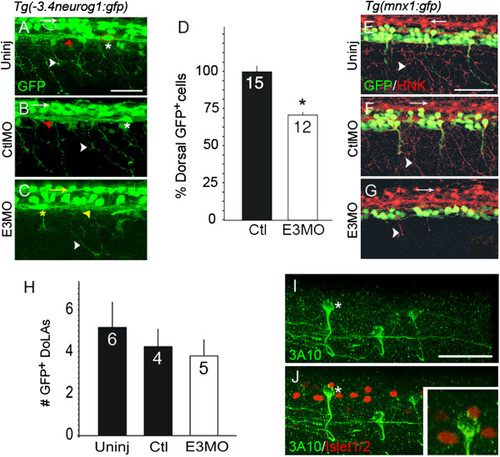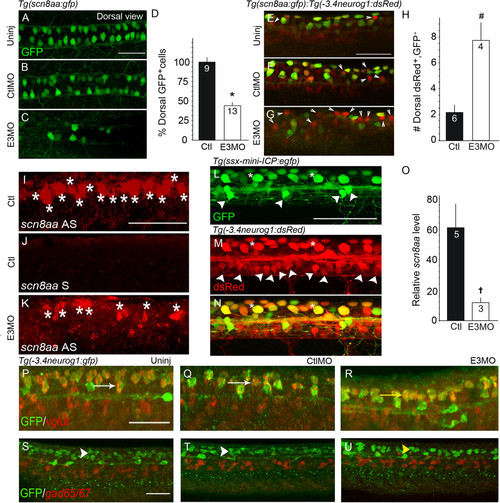- Title
-
Spinal neurons require Islet1 for subtype-specific differentiation of electrical excitability
- Authors
- Moreno, R.L., Ribera, A.B.
- Source
- Full text @ Neural Dev.
|
Caudal primary motor neuron-like neurons have abnormal axonal trajectories that resemble those of interneurons. In all figures, unless indicated otherwise, images present lateral views of embryos (rostral left, dorsal up). (A) In control (Ctl) Tg(mnx1:gfp)ml2 22 to 26 hours post-fertilization (hpf) embryos, primary motor neurons (PMNs) express green fluorescent protein (GFP). The caudal PMN (CaP; large white arrowhead) projects its peripheral axon (small white arrowhead) ventrally. White lines (A, B and C) indicate somite boundaries. (B) In Tg(mnx1:gfp)ml2 E3 morphants, GFP+ cells persist in the ventral spinal cord. GFP+ CaP-like cells (yellow arrowhead) have somas in CaP positions but project axons centrally rather than peripherally. (C) In another Tg(mnx1:gfp)ml2 E3 morphant, a GFP+ CaP-like cell (yellow arrowhead), filled with Alexa 594, has an axon that extends caudally to exit in the neighboring hemisegment (thin yellow arrowhead). (D-L) (D) In uninjected Tg(nrp1a:gfp)js12 embryos, CaP (white arrowhead) has its soma immediately dorsal to the motor axon exit point (white asterisk). (E) E3 morphants have few GFP+ ventral neurons. A CaP-like cell (yellow arrowhead) lacks a peripheral axon. (F, F′) GFP+ PMNs of control Tg(nrp1a:gfp)js12 embryos (F′, white asterisks) express nrp1a. (G, G′) Following Islet1 knock-down, few nrp1a/GFP+ (G′, yellow asterisks) neurons are present. (H-L) In E3 morphants, many GFP+ neurons have axons that bypass normal exit points and extend centrally either caudally (H and I), rostrally (J) or in both directions (K). Occasionally, a GFP+ CaP-like cell extends a peripheral as well as a central axon (L). (M) The top cartoon depicts control CaP axon morphology, and the six lower cartoons exemplify the range of CaP-like axonal phenotypes revealed by either dye filling or confocal analysis of Tg(nrp1a:gfp)js12 E3 morphants. Scale bars = 50 µm in A (for A to C), D (for D and E), F (for F to G′) and H (for H to L). IC, ipsilateral commissural; KA, Kolmer-Agduhr; VeLD, ventral lateral. EXPRESSION / LABELING:
PHENOTYPE:
|
|
Islet1 knock-down reduces the number of dorsal GFP+ neurons in the Tg(-3.4neurog1:gfp)sb4 line. (A-C)Tg(-3.4neurog1:gfp)sb4 24 hours post-fertilization (hpf) Islet1 knock-down reduces the number of dorsal GFP+ neurons in the Tg(-3.4neurog1:gfp)sb4 line embryos express green fluorescent protein (GFP) in Rohon-Beard cells (RBs) [38] (white arrow, white outlined cell as example) and dorsal lateral ascending interneurons (DoLAs; asterisk, red circle). (A) In control embryos, central axons (red arrowhead) and peripheral processes (white arrowhead) are GFP+. (B) The 5-base mismatched islet1(Sp)E3 MO (CtlMO) has no effect on RB or DoLA morphology. (C) After Islet1 knock-down, central axons (yellow arrowhead) and dorsal cells with RB-like (yellow arrow) or DoLA-like (yellow asterisk) somata remain GFP+. However, few peripherally projecting processes are present (white arrowhead in A and B). (D)Tg(-3.4neurog1:gfp)sb4 E3 morphants have 29% less GFP+ dorsal neurons versus controls (*P < 0.0001, t-test). GFP+ RB neurons were counted in 200 µm spinal cord regions (above yolk sac-yolk sac extension boundary). The number in the bar indicates sample size. (E-G)Tg(mnx1:gfp)ml2 embryos were co-processed for GFP and HNK-1-like immunoreactivities to assess both RB (red) and primary motor neuron (PMN; green) peripheral processes. (E) RB somata (white arrows), central axons and peripheral processes (white arrowhead) are HNK-1 positive. (F) CtlMO has no effect on either motor/interneuron (green) or RB (red) morphology. (G) After Islet1 knock-down, few ventral cells express GFP versus uninjected (Uninj) (E) or control (F) embryos. Few HNK-1+ (red) or GFP+ (green) projecting peripheral processes are present. (H) The number of DoLA interneurons (twelve hemisegments) were counted in 24 hpf control and morphant Tg(-3.4neurog1:gfp)sb4 embryos. Islet1 knock-down has no effect on the DoLA interneuron number. (I) Commissural primary ascending interneurons (CoPAs) are positive for anti-neurofilament antibody 3A10 staining (asterisk). (J) In 24 hpf embryos, although several spinal neurons are positive for anti-Islet1/2 immunoreactivity (red), CoPAs are not. Scale bars = 50 µm in A (for A to C), E (for E to G) and I (for I and J). |
|
Islet1 knock-down affects sensory neuron differentiation. (A-C) In control embryos (A, B), Rohon-Beard cells (RBs) express runx3. Islet1 knock-down leads to fewer cells with robust expression of runx3 (C). The asterisk denotes a cell expressing the gene. (D-F′)Tg(-3.4neurog1:gfp)sb4 control (D-E′) and E3 morphant (F, F′) 24 hours post-fertilization (hpf) embryos were examined for expression of olig4 (red). (D-E′) In lateral views of the dorsal spinal cord, RNA in situ hybridization reveals expression of the interneuron marker olig4 (red). Green fluorescent protein (GFP)+ neurons do not express olig4 and comprise RBs and dorsal lateral ascending interneurons (see Figure 2). (F-F′) Islet1 knock-down leads to an increase in the number of olig4 expressing cells within the dorsal spinal cord. However, similar to RBs of control embryos (D-E′), RB-like neurons do not express detectable levels of olig4(F). (G-I) At 72 hpf, dorsal root ganglia (DRGs) are easily identified as GFP+ neurons with large somata located near the spinal cord/notochord border. (G, H) In control embryos, DRG neurons project from their soma bipolar axons that extend dorsally and ventrally (asterisks). (I) Islet1 knock-down reduces the number of GFP+ DRGs. Furthermore, for the few GFP+ DRGs remaining, their axons show abnormal morphologies. Scale bars = 50 µm in A (for A-C), D (for D-F′) and G (for G-I). CtlMO, 5-base mismatched; islet1(Sp)E3MO; E3MO, E3 morpholino; Uninj, uninjected. |

ZFIN is incorporating published figure images and captions as part of an ongoing project. Figures from some publications have not yet been curated, or are not available for display because of copyright restrictions. PHENOTYPE:
|

ZFIN is incorporating published figure images and captions as part of an ongoing project. Figures from some publications have not yet been curated, or are not available for display because of copyright restrictions. PHENOTYPE:
|
|
Islet1 knock-down reduces Rohon-Beard cell number and expression of scn8aa in the dorsal spinal cord. (A-C) In 24 hours post-fertilization (hpf) Tg(scn8aa:gfp)ym1 embryos, Rohon-Beard (RB) and RB-like cells express green fluorescent protein (GFP) (dorsal views) [46]. Islet1 knock-down reduces the number of GFP+ neurons (C versus A and B). (D) In E3 morphants, the number of GFP+ RB-like cells is 44% that of GFP+ RB cells in controls (*P < 0.001) (see Methods). (E-G) In uninjected (Uninj) and control 24 hpf double Tg(scn8aa:gfp,-3.4neurog1:dsRed) embryos, most RB neurons express both reporters (E, F) and few express only dsRed (arrowheads) (lateral views). In E3 morphants, many RB-like cells express only dsRed (G, arrowheads). (H) Compared to RBs, more RB-like cells express only dsRed (#P < 0.01). (I-K) Following Islet1 knock-down (K), less scn8aa mRNA (asterisks) is detected compared to controls (I) (lateral views). (J)The sense control scn8aa probe reveals little signal, indicating specificity of the antisense probe (I and K). (L-N) In 24 hpf double transgenic Tg(ssx-mini-ICP:egfp,-3.4neurog1:dsRed) embryos, most RB cells (asterisks) express both reporter proteins (N). Fewer ventral interneurons express GFP (L) versus dsRed (M) (arrowheads). (O) Quantitative reverse transcription PCR analysis (see Methods) shows a five-fold reduction in scn8aa expression in RB-like cells of E3 morphants (*P < 0.04). (P, Q) RBs express vglut2.1/2.2 mRNA (red) (lateral views). In uninjected and CtlMO injected embryos, vglut2.1/2.2 mRNA (red) colocalizes (white arrows) with GFP+ RBs (green). (R) In E3 morphants, vglut2.1/2.2 mRNA (red) co-localizes with GFP+ RB-like neurons (green; yellow arrow), indicating no obvious effect of Islet1 knock-down. (S, T) GABAergic neurons express gad65/67 mRNA (red). (U) Islet1 knock-down has no obvious effect on gad65/67 in the dorsal domain. Scale bars = 50 µm in A (for A to C), E (for E to G), I (for I to K), L (for L to N), P (for P to R) and S for (S to U). |

ZFIN is incorporating published figure images and captions as part of an ongoing project. Figures from some publications have not yet been curated, or are not available for display because of copyright restrictions. PHENOTYPE:
|

ZFIN is incorporating published figure images and captions as part of an ongoing project. Figures from some publications have not yet been curated, or are not available for display because of copyright restrictions. PHENOTYPE:
|




